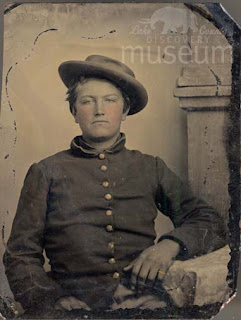Memorial Day was originally known as Decoration Day, a time set aside to honor the nation’s Civil War dead by decorating their graves.
"Fort Sheridan Decoration Day, May 30, 1916." (above) View looking south toward barracks row. (Dunn Museum 92.24.2622)
It’s difficult to pinpoint the origins of the day, but it seems likely that it had many separate beginnings, including women’s groups in the South who decorated graves before the end of the Civil War.
The first widely observed Decoration Day was on May 30, 1868, commemorating the sacrifices of Civil War soldiers by proclamation of General John Logan (1826-1886), national commander of the Grand Army of the Republic. Logan who was from southern Illinois and pro-Southern before the Civil War, decided to join the Northern cause to preserve the Union, and eventually became a general. After the war he served as an Illinois senator from 1871-77 and 1879-1886, and in 1893 was honored with a National Guard weapons training camp named for him—Camp Logan in Zion.
During the 1868 celebration, General James Garfield (1831-1881), later the 20th President of the United States, made a speech at Arlington National Cemetery after which 5,000 participants decorated the graves of the more than 20,000 Union and Confederate soldiers buried there.
The letter above is addressed to Frank Peats, formerly of the 17th Illinois Regiment (Civil War), April 9, 1880. It reads:
Dear Comrade, at our regular meeting last night it was the unanimous wish of the 'Boys' that you be invited to orate for us on Memorial Day and your humble servant was instructed to write you in regard to it - not a long talk you know but one of your usual patriotic efforts will please them. How is it Frank. Can you come? I wish you would. Yours Hastily, Y.R. Swieley.
When the Civil War broke out in April 1861, Peats wrote his fiancee saying that he had to engage in the "struggle between the sons of freedom and traitors to every principle of right and justice." (Frank Peats Collection, Dunn Museum 94.5.211)
By 1890, Decoration Day was recognized by all of the northern states. The South continued to honor their dead on different days until after World War I when the holiday changed from honoring just those who died fighting in the Civil War to honoring Americans who died fighting in any war. In 1971, Congress declared Memorial Day a national holiday to be celebrated the last Monday in May.
"German War Veterans' Memorial Day Service, May 29, 1972, Fort Sheridan." (Dunn Museum 92.24.1821)
In 1944, Fort Sheridan assumed control of prisoner of war camps in Illinois, Michigan and Wisconsin—a total of 15,000 prisoners of war. German POWs were housed in newly constructed barracks at the south end of the Fort. Nine German POWs are buried at the Post Cemetery. However, none of these men died at Fort Sheridan.
"Memorial Day Services held at the Post Cemetery flagpole at Fort Sheridan, May 27, 1974."
(Dunn Museum92.24.1785)




































